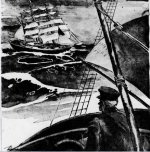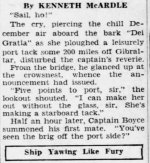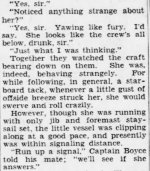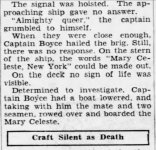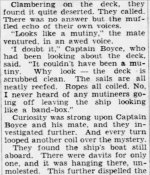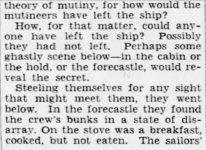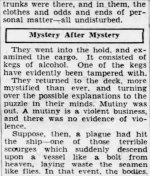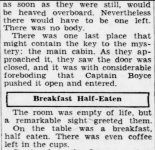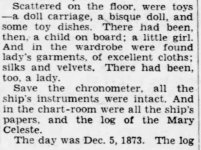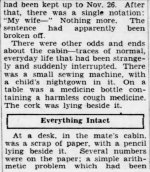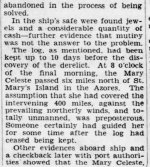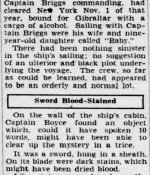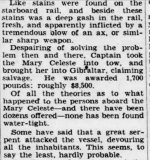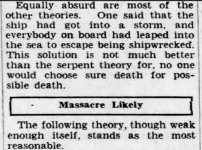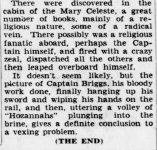Navigation
Install the app
How to install the app on iOS
Follow along with the video below to see how to install our site as a web app on your home screen.
Note: This feature may not be available in some browsers.
More options
You are using an out of date browser. It may not display this or other websites correctly.
You should upgrade or use an alternative browser.
You should upgrade or use an alternative browser.
the Mary Celeste
- Thread starter jeff of pa
- Start date
Rebel - KGC
Gold Member
- Jun 15, 2007
- 21,663
- 14,726
Truly VEXING, it is... I remember that sea story.
- Thread starter
- #3
The strangest part, With the Exception of the Blood on the Sword & Railing,
Everyone seemed to have Not Fought.
Like they cleaned the ship & De-boarded
If the Sword was used for that Event, Why Sheath it Bloody ?
If the Captain Did it, why didn't he Finish his Sentence "My Wife...."
after putting the Sword away ?
If someone took the sword from The Captain, Why Sheath It ?
If the Sword was used that Day,, There should have been Blood Elsewhere.
Why Clean then Jump overboard.
& If in a Cleaning mood, Why not clean the Sword Too ?
Everyone seemed to have Not Fought.
Like they cleaned the ship & De-boarded
If the Sword was used for that Event, Why Sheath it Bloody ?
If the Captain Did it, why didn't he Finish his Sentence "My Wife...."
after putting the Sword away ?
If someone took the sword from The Captain, Why Sheath It ?
If the Sword was used that Day,, There should have been Blood Elsewhere.
Why Clean then Jump overboard.
& If in a Cleaning mood, Why not clean the Sword Too ?
Last edited:
Rebel - KGC
Gold Member
- Jun 15, 2007
- 21,663
- 14,726
MYSTERIES, MYSTERIES, MYSTERIES! More "High-Test" COFFEE!
- Thread starter
- #5
Rebel - KGC
Gold Member
- Jun 15, 2007
- 21,663
- 14,726
Heh...
Blak bart
Gold Member
I have read much about this.....2 other theories not mentioned here I have read elsewhere. One is that everyone got ergot poisoning from bad bread.....they would have had a trip like LSD and all went crazy and were thrown overboard, killed, or jumped over on a physcodelic trip. Another is the cargo of alcohol. It is thought that there was a fear of explosion or fire from alcohol fumes.....the captain and crew boarded a small dingy that was in tow to allow the alcohol fumes to dissipate there tow line parted or came un cleated and they were lost as there ship slowly sailed out of reach. I always had my own ideas.....perhaps someone was sipping that alcohol and went nuts and killed everyone and then lept overboard in there own alcohol poisoned madness. I've read the account many times since I was a boy and will wonder the rest of my days what really happened ? Perhaps the story from old captain boyce was just that....a story. Would be plausible to board in the middle of a meal, call everyone on deck, dispatch them and claim the ship for salvage !! 8500$ was quite a bit of money back then.....really it was a fortune for a ships captain.
Treasureman25
Sr. Member
- May 30, 2013
- 257
- 374
- Detector(s) used
- Mxt pro, coinmaster gt, bounty hunter
- Primary Interest:
- All Treasure Hunting
- Jan 11, 2004
- 120
- 125
- Detector(s) used
- Goldpic,XP ,
- Primary Interest:
- All Treasure Hunting
There is this book "Il mito del Mary Celeste" by Vero Roberti
Could not find an english version only a german one ,which i have .
Has some scetches , maps , complete list of passenger´s (crew) . But no solution !
Tells of varios theories and some more as Black Bart was posting
greetings
Could not find an english version only a german one ,which i have .
Has some scetches , maps , complete list of passenger´s (crew) . But no solution !
Tells of varios theories and some more as Black Bart was posting
greetings
ArfieBoy
Silver Member
- Aug 11, 2011
- 3,903
- 6,771
- Detector(s) used
- Compass X-70, Compass X-80, Compass X-90, Compass Judge 2, Garrett AT Pro
- Primary Interest:
- All Treasure Hunting
Weirdness abounds! 

- Thread starter
- #12
No matter what, If the Truth is the Ship was Cleaned & all was in Order.
Nothing Adds up But Teleportation where they Sat & Stood.
Which Doesn't quite Add up either.
People Litter ! Especially Back then,.
People Forget things, & Feel they Need to go Back.
People loose track of Their Loved ones & Freak out.
& Probably even More when there is any type of frantic activity.
also Don't forget. Even on Hallucinogens , There is such a thing as Paranoia,
But a Mass Hallucinogen that effects everyone exactly the Same ?
Ever see people Calmly Exit ?
the fear of even Breathing wrong would have to be Overpowering,
To keep a whole ship calm.
Nothing Adds up But Teleportation where they Sat & Stood.
Which Doesn't quite Add up either.
People Litter ! Especially Back then,.
People Forget things, & Feel they Need to go Back.
People loose track of Their Loved ones & Freak out.
& Probably even More when there is any type of frantic activity.
also Don't forget. Even on Hallucinogens , There is such a thing as Paranoia,
But a Mass Hallucinogen that effects everyone exactly the Same ?
Ever see people Calmly Exit ?

the fear of even Breathing wrong would have to be Overpowering,
To keep a whole ship calm.
Last edited:
monicapapo
Newbie
- Feb 15, 2020
- 2
- 4
- Detector(s) used
- Garrett AT Pro
- Primary Interest:
- All Treasure Hunting
Sounds like the movie "Ghost Ship"
Red-Coat
Gold Member
Indeed this remains a mystery but, like so many contemporary and later accounts, much of what that Pittsburgh Press 1934 article says to compound the mystery is completely untrue. It draws on exaggeration for the purposes of sensationalism, second-hand reporting of unverified information and fictional stories. Just to point out some howlers:
The ship was most certainly not “looking like a band-box” when found. Mary Celeste’s sails were in poor condition with not only some of them unset, but missing altogether. Much of the rigging was damaged and there were ropes strewn all over the deck, with some hanging loosely over the side.
The ship’s boat was not still on board, “hanging in the davits”. Mary Celeste carried only a small yawl to act as a lifeboat which had been stowed across the main hatch. It was missing and has never been found.
The story of a breakfast cooked but not eaten on the stove is a complete myth, as is the account of a breakfast half-eaten in the main cabin. Pure invention. There was no food prepared or under preparation.
There is no mystery about the children’s toys or the fine women’s clothes. It’s well documented that Captain Briggs had made arrangements for his wife and daughter to accompany him on this trip.
The story about the last log entry being “My wife…” as an unfinished sentence by Briggs is also a complete fabrication. There was no such entry. The final log entry was a mundane report of the ship’s position on November 25th and the log was found in the mate’s cabin.
There was no bloodstained sword and no bloodstained railing. Within a couple of weeks of the ship’s recovery, examination of samples under a microscope revealed that neither of the reddish stains were blood. The stains on the sword were established to be iron citrate, probably as a result of the blade having been cleaned using a lemon.
It’s also worth mentioning that one of the ship’s bilge pumps had been dismantled and there was three and a half feet of water in the hold. Although that wouldn’t have put a ship of this size in danger, it’s likely Briggs was concerned. A makeshift sounding rod for checking the depth of water in the hold was found abandoned on the deck and the hold was so tightly packed with cargo that it would have been nigh on impossible to use it in any meaningful way to assess whether the ship was taking on water at a dangerous rate.
It’s also worth mentioning that ‘Mary Celeste’ is an anagram of ‘met scary eel’. Coincidence? I think not.
The ship was most certainly not “looking like a band-box” when found. Mary Celeste’s sails were in poor condition with not only some of them unset, but missing altogether. Much of the rigging was damaged and there were ropes strewn all over the deck, with some hanging loosely over the side.
The ship’s boat was not still on board, “hanging in the davits”. Mary Celeste carried only a small yawl to act as a lifeboat which had been stowed across the main hatch. It was missing and has never been found.
The story of a breakfast cooked but not eaten on the stove is a complete myth, as is the account of a breakfast half-eaten in the main cabin. Pure invention. There was no food prepared or under preparation.
There is no mystery about the children’s toys or the fine women’s clothes. It’s well documented that Captain Briggs had made arrangements for his wife and daughter to accompany him on this trip.
The story about the last log entry being “My wife…” as an unfinished sentence by Briggs is also a complete fabrication. There was no such entry. The final log entry was a mundane report of the ship’s position on November 25th and the log was found in the mate’s cabin.
There was no bloodstained sword and no bloodstained railing. Within a couple of weeks of the ship’s recovery, examination of samples under a microscope revealed that neither of the reddish stains were blood. The stains on the sword were established to be iron citrate, probably as a result of the blade having been cleaned using a lemon.
It’s also worth mentioning that one of the ship’s bilge pumps had been dismantled and there was three and a half feet of water in the hold. Although that wouldn’t have put a ship of this size in danger, it’s likely Briggs was concerned. A makeshift sounding rod for checking the depth of water in the hold was found abandoned on the deck and the hold was so tightly packed with cargo that it would have been nigh on impossible to use it in any meaningful way to assess whether the ship was taking on water at a dangerous rate.
It’s also worth mentioning that ‘Mary Celeste’ is an anagram of ‘met scary eel’. Coincidence? I think not.

Bum Luck
Silver Member
- May 24, 2008
- 3,482
- 1,282
- Detector(s) used
- Teknetics T2SE, GARRETT GTI 2500, Garrett Infinium
- Primary Interest:
- All Treasure Hunting
Indeed this remains a mystery but, like so many contemporary and later accounts, much of what that Pittsburgh Press 1934 article says to compound the mystery is completely untrue. It draws on exaggeration for the purposes of sensationalism, second-hand reporting of unverified information and fictional stories. Just to point out some howlers:
The ship was most certainly not “looking like a band-box” when found. Mary Celeste’s sails were in poor condition with not only some of them unset, but missing altogether. Much of the rigging was damaged and there were ropes strewn all over the deck, with some hanging loosely over the side.
The ship’s boat was not still on board, “hanging in the davits”. Mary Celeste carried only a small yawl to act as a lifeboat which had been stowed across the main hatch. It was missing and has never been found.
The story of a breakfast cooked but not eaten on the stove is a complete myth, as is the account of a breakfast half-eaten in the main cabin. Pure invention. There was no food prepared or under preparation.
There is no mystery about the children’s toys or the fine women’s clothes. It’s well documented that Captain Briggs had made arrangements for his wife and daughter to accompany him on this trip.
The story about the last log entry being “My wife…” as an unfinished sentence by Briggs is also a complete fabrication. There was no such entry. The final log entry was a mundane report of the ship’s position on November 25th and the log was found in the mate’s cabin.
There was no bloodstained sword and no bloodstained railing. Within a couple of weeks of the ship’s recovery, examination of samples under a microscope revealed that neither of the reddish stains were blood. The stains on the sword were established to be iron citrate, probably as a result of the blade having been cleaned using a lemon.
It’s also worth mentioning that one of the ship’s bilge pumps had been dismantled and there was three and a half feet of water in the hold. Although that wouldn’t have put a ship of this size in danger, it’s likely Briggs was concerned. A makeshift sounding rod for checking the depth of water in the hold was found abandoned on the deck and the hold was so tightly packed with cargo that it would have been nigh on impossible to use it in any meaningful way to assess whether the ship was taking on water at a dangerous rate.
It’s also worth mentioning that ‘Mary Celeste’ is an anagram of ‘met scary eel’. Coincidence? I think not.
Interesting - got a source?
Red-Coat
Gold Member
Interesting - got a source?
There's a reasonable summary of what was and was not found in the Wiki entry, together with additional references to findings by the Court of Enquiry:
https://en.wikipedia.org/wiki/Mary_Celeste
Some additional information at the link below:
The Mary Celeste - fact not fiction
And some interesting background here:
https://gibraltar-intro.blogspot.com/2012/10/1872-mary-celeste-outdone-by-his_11.html
- Aug 19, 2014
- 38,249
- 138,898
- Detector(s) used
- JW 8X-ML X2-VP 585
- Primary Interest:
- All Treasure Hunting
For those that enjoyed this particular mystery "ghost ship"... I will add...
This ship was only ONE of MANY that have been found over time in basically in same state.
There was the Hermania in 1849... and the Marathon in 1855.
And the case of the Ellen makes the Mary look like an open and shut case.
This ship was only ONE of MANY that have been found over time in basically in same state.
There was the Hermania in 1849... and the Marathon in 1855.
And the case of the Ellen makes the Mary look like an open and shut case.
- Aug 19, 2014
- 38,249
- 138,898
- Detector(s) used
- JW 8X-ML X2-VP 585
- Primary Interest:
- All Treasure Hunting
PS...
For you peeps like me...
1894 the US Hydrographic Office published a 25-page report titled Wrecks and Derelicts in the North Atlantic Ocean, 1887 to 1893, Inclusive: Their Location, Publication, Destruction, Etc.
For you peeps like me...
1894 the US Hydrographic Office published a 25-page report titled Wrecks and Derelicts in the North Atlantic Ocean, 1887 to 1893, Inclusive: Their Location, Publication, Destruction, Etc.
Users who are viewing this thread
Total: 2 (members: 0, guests: 2)


